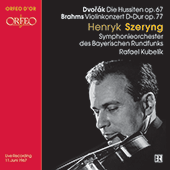Henryk Szeryng
Henryk Szeryng was born in the same tiny town as Chopin, taking Mexican citizenship after World War II. He was taught piano by his mother from the age of five, and received his first formal violin lessons two years later from Maurice Frenkel, a former pupil of Leopold Auer. After hearing Szeryng play Mendelssohn’s Violin Concerto, Huberman advised him to go to Berlin to finish his training; this he did, first under Willy Hess, then with Carl Flesch.
During World War II Szeryng gave over 300 concerts for Allied troops, later moving to Mexico to serve on the staff of the exiled Polish premier General Sikorski. His concerts thereafter were mostly near his new home, although meeting Arthur Rubinstein in 1950 precipitated a number of tours elsewhere. Szeryng was awarded the Grand Prix du Disque six times and other accolades for his recordings, as well as a significant number of national honours. Thus, as with Stern and Menuhin, his musical achievements were balanced by a strong desire to use his international reputation to beneficial effect.
Szeryng’s recordings testify to a surefooted and muscular artist, akin to many of the newer talents emerging in the first third of the twentieth century, with a sound that increasingly embodied stylistic similarity with his contemporaries. As with many of these players, a powerful, sonorous tone is the defining characteristic, with a pervasive and conspicuous vibrato, and a generally precise approach to the written score.
His Bach playing was famously effective and has been represented here by the BWV 1006 Partita, recorded in 1965. In general there is a reflective solidity to the playing – it is never rushed – the Loure, for example, sounding considered; the Gavotte clean and articulated. In Classical repertoire Szeryng uses such qualities to good effect, as in a steady and respectful reading of Mozart’s Violin Concerto, K. 216 from 1960. His ‘Spring’ Sonata with Arthur Rubinstein from two years earlier has all the charisma one would expect of such an illustrious pairing, with a very direct dialogue between the players.
Szeryng recorded Beethoven’s Violin Concerto a number of times, and a Concertgebouw Orchestra performance under Haitink from 1973 shows that the artist, now in his fifties, has lost a little of his earlier lustre; this is an entirely conventional performance, with relatively uncontroversial tempi and tonal characteristics. These remarks apply similarly to his reading of Brahms’s Violin Concerto with Haitink from the same period.
In nineteenth-century repertoire, Szeryng’s big-toned approach and steady pacing is undoubtedly a long way from period practices. Nonetheless, as an exponent of what might be called the new Post-Romantic sound Szeryng is a more effective communicator than most, making up for such matters in the breadth of his approach. His recording of Brahms’s Op. 108 with Rubinstein (who had met and been infl uenced by Joseph Joachim) from 1960 is soulful, with some tempo rubato in the fi rst movement and a distinctly monumental approach. Two performances from Library of Congress recitals in 1971 – Brahms’s Op. 78 Sonata and Schumann’s Op. 105 with Gary Graff man – exhibit similar characteristics, the Schumann in particular making up for what might be considered compositional weaknesses by a large tone and impassioned delivery. Szeryng does not quite manage this feat with Schumann’s Violin Concerto (recorded in 1964) which, despite all his eff orts, limps along, displaying good reason perhaps for Joachim’s attempt to censor it. Ponce’s Violin Concerto, recorded in 1984, shows that Szeryng retained many of his powers into old age. His vibrato is too slow in the slow movement, but Ponce’s enigmatic yet vivacious language is conveyed convincingly by its dedicatee.
© Naxos Rights International Ltd. — David Milsom (A–Z of String Players, Naxos 8.558081-84)


















